Talladega National Forest NEON (TALL) Soil Descriptions
Distributed Soils Reports
Pedon Descriptions
Pit‐level observations and field measurements reported using the standard NRCS format. They contain volume estimates for coarse fragments > 20 mm where applicable.
Site Level Plot Summary
A narrative summary that places the sampled soil pedons in the broader context of soils and geomorphology for the entire NEON site.
Megapit Images

D08 TALL megapit soil profile 0-62 cm
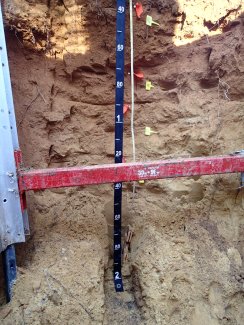
D08 TALL megapit soil profile 35-200 cm
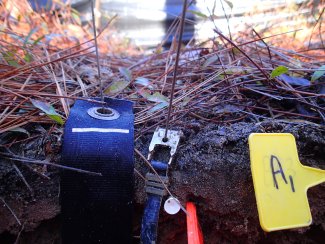
D08 TALL megapit soil profile 0-7 cm

D08 TALL megapit soil profile 1-51 cm
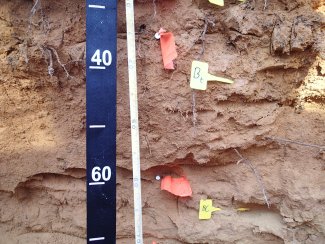
D08 TALL megapit soil profile 30-71 cm
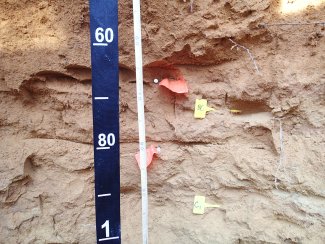
D08 TALL megapit soil profile 54-101 cm
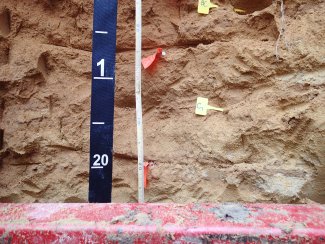
D08 TALL megapit soil profile 85-128 cm
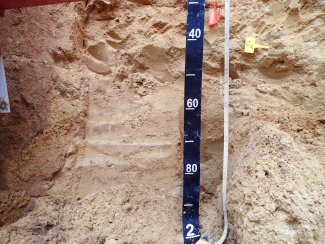
D08 TALL megapit soil profile 130-200 cm
Megapit Pedon Description
| Print Date | Jul 22 2015 |
|---|---|
| Description Date | Jan 13 2014 |
| Describer | Milton Tuck, Lawrence McGhee |
| Site ID | S2014AL007001 |
| Pedon ID | S2014AL007001 |
| Lab Source ID | KSSL |
| Lab Pedon # | 15N0538 |
| Soil Name as Described/Sampled | Smithdale |
| Classification | Fine-loamy, siliceous, subactive, thermic Typic Hapludults |
| Pedon Type | confirmation description |
| Pedon Purpose | research site |
| Taxon Kind | series |
| Associated Soils | Boykin, Maubila |
| Geomorphic Setting | on backslope of side slope of coastal plain |
| Upslope Shape | convex |
| Cross Slope Shape | linear |
| Particle Size Control Section | 37 to 78 cm. |
| Description origin | NASIS |
| Country | United States |
| State | Alabama |
| County | Bibb |
| MLRA | 133A -- Southern Coastal Plain |
| Map Unit | MsF -- Maubila-Smithdale complex, 15 to 35 percent slopes |
| Quad Name | Payne Lake, Alabama |
| Std Latitude | 32.9510611 |
| Std Longitude | -87.3941000 |
| Latitude | 32 degrees 57 minutes 3.82 seconds north |
| Longitude | 87 degrees 23 minutes 38.76 seconds west |
| Datum | WGS84 |
| UTM Zone | 16 |
| UTM Easting | 463164 meters |
| UTM Northing | 3645931 meters |
| Primary Earth Cover | Tree cover |
| Parent Material | thick beds of loamy marine sediments |
| Description database | KSSL |
| Diagnostic Features | ochric epipedon 0 to 37 cm. argillic horizon 37 to 93 cm. |
| Slope (%) | 15.0 |
| Elevation (meters) | 154.0 |
| Aspect (deg) | 330 |
| MAAT (C) | 18.1 |
| MAP (mm) | 1,440 |
| Frost-Free Days | 236 |
| Drainage Class | well |
| Slope Length (meters) | 23 |
| Horizon Details |
A1--0 to 10 centimeters (0.0 to 3.9 inches); dark brown (7.5YR 3/3) rubbed sandy loam; weak fine granular structure; fine roots throughout; noneffervescent; moderately acid, pH 6.0, pH indicator solutions; clear smooth boundary. Lab sample # 14N01527 A2--10 to 25 centimeters (3.9 to 9.8 inches); brown (7.5YR 4/4) broken face sandy loam; moderate fine granular structure; medium roots throughout and fine roots throughout and coarse roots between peds; noneffervescent; moderately acid, pH 6.0, pH indicator solutions; clear wavy boundary. Lab sample # 14N01528 BE--25 to 37 centimeters (9.8 to 14.6 inches); brown (7.5YR 5/4) broken face sandy loam; weak coarse subangular blocky, and moderate fine granular structure; medium roots between peds and fine roots between peds; noneffervescent; strongly acid, pH 5.5, pH indicator solutions; gradual wavy boundary. Lab sample # 14N01529 Bt--37 to 75 centimeters (14.6 to 29.5 inches); yellowish red (5YR 5/6) broken face sandy clay loam; moderate medium subangular blocky, and weak medium subangular blocky structure; medium roots between peds and fine roots between peds; noneffervescent; very strongly acid, pH 5.0, pH indicator solutions; gradual wavy boundary. Lab sample # 14N01530 BC--75 to 93 centimeters (29.5 to 36.6 inches); reddish yellow (5YR 6/6) broken face sandy loam; weak coarse subangular blocky structure; fine roots between peds; noneffervescent; very strongly acid, pH 5.0, pH indicator solutions; clear wavy boundary. Lab sample # 14N01531 C1--93 to 130 centimeters (36.6 to 51.2 inches); reddish yellow (7.5YR 6/6) broken face loamy sand; structureless coarse massive; fine roots between peds; noneffervescent; very strongly acid, pH 5.0, pH indicator solutions; clear wavy boundary. Lab sample # 14N01532 C2--130 to 200 centimeters (51.2 to 78.7 inches); reddish yellow (7.5YR 6/8) broken face loamy sand; structureless coarse massive; 20 percent medium distinct masses of reduced iron along lamina or strata surfaces; noneffervescent; very strongly acid, pH 5.0, pH indicator solutions. Lab sample # 14N0153 |
Credits: This megapit soil pedon description was generously created by USDA Natural Resource Conservation Service staff, with particular thanks to Larry West, Jon Hempel, and numerous field staff.